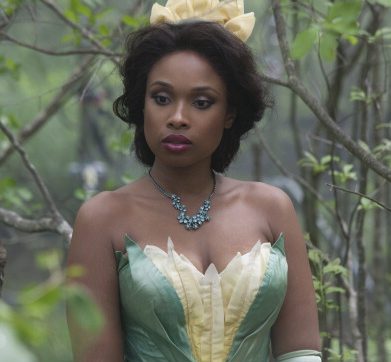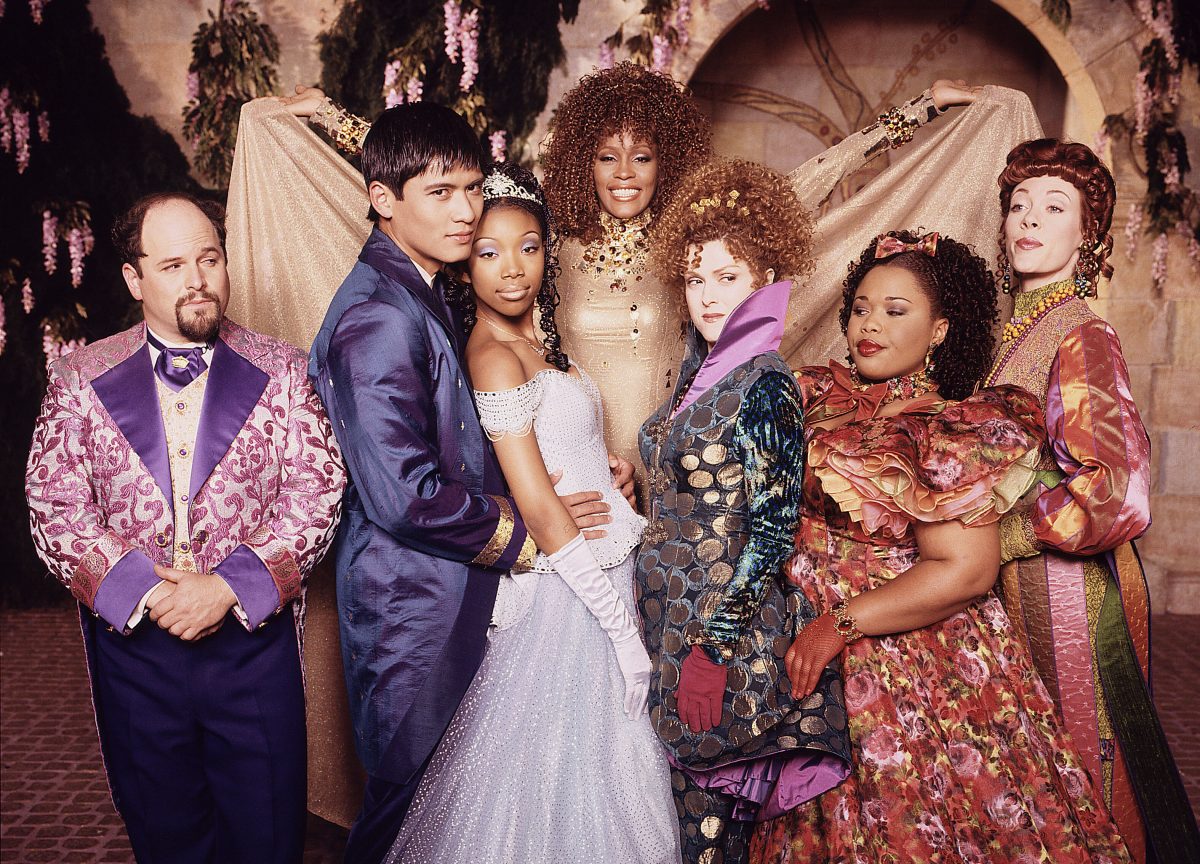
Source: Handout / Getty
There was once a time I saw magic in the future. It was before it became a Black girl hashtag and before fantasies were reserved for children. It was 1997 and I was 6 years old. I watched Brandy do the impossible alongside Whitney Houston in a tale of forsaken circumstances suddenly changed by remarkable fortune.
Peripherally speaking, it was a Black princess with braids for me. But fundamentally, what it left in my heart, went unclear for years.
Unbeknownst to me and many other Black girls, there was a princess who splashed across screens nationwide eight years prior and possessed an unforgettable, distinctive look. A porcelain-skinned wonder with epic blue eyes and bright red hair, clothed in a purple bra made of seashells and a light green fish tail.
But it seems 2023 promises to see the departure of the undersea princess from her classic appearance. Just like my 1997 Cinderella, Ariel will be real and Black, but critics want to see her go back from that.
On July 3, 2019, Disney announced that American singer and actress, Halle Bailey would be casted as Princess Ariel in the 2023 live-action remake of The Little Mermaid, as well as performing on the soundtrack for the film.
“After an extensive search, it was abundantly clear that Halle possesses that rare combination of spirit, heart, youth, innocence, and substance — plus a glorious singing voice — all intrinsic qualities necessary to play this iconic role.” — Rob Marshall, Director of The Little Mermaid (2023)
Shortly after the announcement, Bailey received widespread controversy, with critics contending that casting an African American in the role of Ariel was “unfaithful” to the appearance of the original character. Social media critics even launched a hate campaign against Bailey called #NotMyAriel.
In a 2020 Teen Vogue interview, Bailey opened up about the criticism:
“We’ve always learned to just keep our heads up no matter the situation. No matter what anybody has to say about you… just keep pushing.”
Last month on Sept. 9, 2022, the film’s teaser trailer was released to the public; reawakening the anticipation for the upcoming movie and reigniting old, racist convictions.
Cue to the future, I am 31 and a woman, in a world where grown white people are popping their veins over a Black girl playing a mermaid in a fairytale, simply because the original was white.
Fairytales are supposed to be the perfect world to escape, but I guess where a Black girl is concerned it defeats their purpose.
But on a serious note, can a Black girl survive in a fairytale world free from the crippling concept of racism and colorism?
If you look at history to inform Black girl representation in fairylands, you may find yourself on a quick spin around the block. That is because Black girls and fairytales are hard to come by. The cornerstone of fairytales was originally marked by seemingly unreal beauty, perfection, fortune, and happiness suitable for children.
While there have been significant strides in challenging the sameness of the classic fairytale, such as incorporating spiritual beliefs, cultures, and more diverse audiences — and while such strides have journeyed us through princess adventures, falling in love, and having worlds turned upside down then being made all the better by a magical fortune, the one thing that remains current is that Black women and girls look to these stories and rarely feel it could happen to them.
And even in those rare occurrences, in a real Black girl’s world, the sabotaging effects of racism and colorism often keep us from receiving the sometimes perfect escape or portrayal we deserve.

Source: Disney / Disney
In 1993, television writer Robert Freedman began working on the already once remade Rodgers & Hammerstein version of Cinderella. With Freedman’s modernized attempt to appeal to contemporary audiences, Rodgers & Hammerstein became the first to adapt Cinderella for a racially diverse cast and audience.
“I really did feel like a princess. I knew that this was so great for the world to see, especially Black people.” — Brandy on Cinderella: The Reunion, A Special Edition of 20/20.
“When it came to white beauty standards, I thought I was ugly. And then I turned out to be the first Black princess. That’s pretty mind-blowing.”
Not only did Rodgers & Hammerstein’s remake of Cinderella appeal to diverse audiences, but it also seemed to sing a Black girl’s song—attempting to make the best of every situation in a world that only seemed to hand you rags, but no riches.
The fairytale logic is that if you make the best out of kindness and hard work, you will reap the reward. And seeing a Black Cinderella in 1997 gain freedom and happiness from a life of oppression was probably the first time many of us saw a Black girl get what she deserved.
Though the unprecedented diversity represented in Rodgers & Hammerstein’s Cinderella was groundbreaking and reflected the times of society, it was released to mixed reviews from critics who felt the film was inferior to previous versions. However, the film would go on to receive several accolades and is regarded as one of the best diverse films made to date.
Brandy, the first Black Cinderella, paved the way for others such as Keke Palmer, Anika Noni Rose, and the now Halle Bailey, to play the previously unthinkable role of a princess while undoing a painful message that only white people belonged in fairytales.
Witnessing a Black princess and fairy godmother connecting and making dreams come true in a diverse world, impacted viewers in ways that should have been rethought and reexplored many times throughout the years— especially for Black women.
However, it seems the world has consciously decided to turn back in the opposite direction of Rodgers & Hammerstein’s 1997 classic— leaving roles and fairytale representation for Black women more few and far between than ever.
“Up where they walk, up where they run
Up where they stay all day in the sun
Wanderin’ free, wish I could be
Part of that world.”
— Part of Your World by Jodi Benson from The Little Mermaid
The theme of The Little Mermaid deals with unrequited love, alienation, and the quest for humanity. The young mermaid, Ariel longs to be a part of a world where she can experience love and humanness, and is willing to sacrifice her life in the sea for a chance at both.
Ariel’s journey to love and humanhood is not without its challenges and roadblocks. The young mermaid is tested, suffers excruciating pain, and experiences heartbreak in order to reap a happy ending.
Like Cinderella and The Little Mermaid, the overall logic of the fairytale similarly resonates with Black women, but in real life, often excludes the part where we reap the benefits.
Because imagine living desperately to be seen as human, and willing to sacrifice everything to be a part of a world free from everything that’s made you feel pain or struggle, only to be robbed of the happily ever after you’ve long deserved.
And what if instead of crippling Black women from such portrayals, we are given support enough to be represented on a regular basis?
I was once concerned about whether a Black girl could survive in a world free from the crippling concept of racism and colorism. Critics have contended that the issue is not about race, but about the idea that a Black woman has been injected into a narrative, who historically looks completely opposite of the original character.
But if Black women and girls can live in a world into which their histories were injected and to which they were robbed of claiming the benefits of their historical contributions, then surely; a Black girl can be injected into the fairytale and claim the world she deserves.
To be clear, Black female representation in fairytales is not a quest to be shown as perfect nor as a solution; we live in a real enough world to know representation doesn’t save us every day or in every way. We know the difference between a trope, a fairytale, and a truly developed character. We know there’s a real-world waiting for us even after happily ever after.
RELATED CONTENT: Brandy Reflects On Recording With Whitney Houston For Rodgers & Hammerstein’s Cinderella
What we don’t know is a world where we never have to worry about justifying what we deserve. For us, the objective behind our support in casting a Black princess was never for special treatment or even to simply escape in a world where we’re shown as an unreal beauty or perfection— even though we already look like we stepped out of a fairytale in real life.
However, the point of this matter is that Black women and girls deserve to feel what I now realize I felt when I first saw Brandy in Cinderella.
And that is the magic of just being seen, period.
Black women and girls deserve happy endings, even if it’s sometimes only shown in fairytales. We deserve to have conceivable thoughts about requited love and a life that shows us as a part of the human world.
The time is long overdue for another Black female heroine to inspire a new generation of Black women and girls. Though the fairytale portrayal of us marked by beauty and royalty will be nothing short of magical, there is something even more enchanting about being inspired to be seen as ourselves.
RELATED CONTENT: Halle Bailey Said Filming ‘The Little Mermaid’ Changed Her Life









